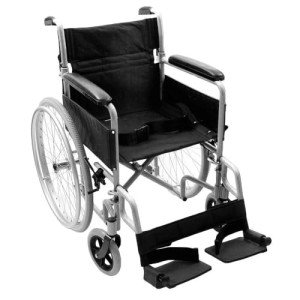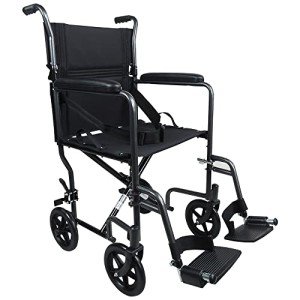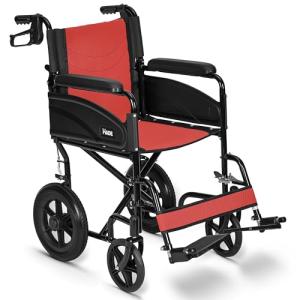Transit wheelchairs are a game changer when it comes to getting around with ease. They're lightweight, easy to transport, and designed for those who need a little extra help without sacrificing comfort. Whether you're heading to the store or going on a day trip, these chairs make mobility a breeze.
Transit Wheelchairs
Convenient and comfortable options for easy mobility on the go
Product List

NRS Transit-Lite Wheelchair - Grey
Nrs Healthcare
Product Review Score
4.41 out of 5 stars
47 reviews$301.04





Crash-Tested Folding Wheelchair
Fenetic Wellbeing
Product Review Score
4.53 out of 5 stars
168 reviews$189.04
When it comes to mobility solutions, transit wheelchairs play a crucial role in assisting individuals with limited mobility. These specially designed chairs provide the necessary support and ease of movement in various environments, from airports to hospitals and shopping malls. In this comprehensive guide, we will explore the different types of transit wheelchairs, their unique features, factors to consider when purchasing one, and some frequently asked questions.
What is a Transit Wheelchair?
A transit wheelchair, often referred to as a transport chair, is a lightweight wheelchair designed for patients or individuals who can’t self-propel. Unlike standard wheelchairs, transit wheelchairs are typically pushed by a caregiver or an attendant. They are designed for short-term use and are predominantly used for transport over short distances.
Key Features of Transit Wheelchairs
- Lightweight Design: Most transit wheelchairs weigh between 15 to 25 pounds, making them easy to carry and maneuver.
- Foldable: Many models are foldable, allowing for convenient storage and transport in vehicles.
- Narrow Width: Transit wheelchairs are often designed with a narrower frame, ideal for navigating tight spaces like doorways and hallways.
- Comfortable Seating: Cushioned seats and backrests increase comfort during transport.
- Safety Features: Many models come with seat belts and anti-tippers to enhance user safety.
Types of Transit Wheelchairs
| Type | Description | Ideal Use Cases |
|---|---|---|
| Standard Transit Chair | Basic model without customization options. Lightweight and cost-effective. | Hospitals, clinics, and events. |
| Transport Chair with Footrests | Features foldable footrests for added comfort and support. | Longer durations of use. |
| Reclining Transit Chair | This model has reclining capabilities for users who need a more comfortable position while seated. | Long-distance travel or comfort needs. |
| Bariatric Transit Wheelchair | Designed for larger individuals, providing a wider seat and enhanced weight capacity. | Healthcare facilities catering to bariatric patients. |
Benefits of Using a Transit Wheelchair
Transit wheelchairs offer various advantages for users and caregivers alike:
- Ease of Use: They are designed for effortless maneuverability, making transport easier for caregivers.
- Versatility: They can be used in multiple settings—including home care, nursing homes, and hospitals.
- Portability: Their lightweight and foldable nature makes it easy to transport them in vehicles.
- Affordability: Generally more affordable than electric wheelchairs, making them accessible for various budgets.
Factors to Consider Before Purchasing a Transit Wheelchair
Choosing the correct transit wheelchair involves careful consideration of different factors. Here’s a checklist to aid in your decision-making:
- User's Needs: Consider the user’s physical capabilities and how often the chair will be used.
- Weight Capacity: Ensure the wheelchair can accommodate the user’s body weight comfortably.
- Size and Dimensions: Measure doorways, hallways, and other spaces the wheelchair will navigate to ensure a good fit.
- Comfort Level: Look for cushioned seating and adjustable footrests for longer trips.
- Durability and Materials: Wheelchairs made from robust materials offer better longevity.
- Safety Features: Check for safety belts, anti-tippers, and strong brakes.
Maintenance Tips for Transit Wheelchairs
To maintain a transit wheelchair and ensure its longevity, consider the following:
| Maintenance Task | Frequency |
|---|---|
| Check tire inflation | Monthly |
| Inspect frame for rust or damage | Every 3 months |
| Clean seat and footrests | Weekly |
| Lubricate wheel locks and hinges | Every 6 months |
Frequently Asked Questions (FAQ)
1. Who should use a transit wheelchair?
Transit wheelchairs are ideal for individuals who cannot self-propel due to mobility limitations, temporary injuries, or conditions requiring assistance during transport.
2. Are transit wheelchairs suitable for long-distance travel?
While transit wheelchairs are primarily for short distances, some models, such as those with reclining features, can accommodate longer durations when used for travel.
3. How do I choose the right size for a transit wheelchair?
It’s crucial to measure both the user’s height and weight, taking into account seat width and depth. Many manufacturers provide sizing charts to help potential buyers.
4. Can transit wheelchairs be used outdoors?
Yes, transit wheelchairs can be used outdoors; however, it is important to choose a model with durable tires that can handle different terrains.
5. Do transit wheelchairs come with warranties?
Most manufacturers offer warranties for their transit wheelchairs, which usually cover parts for a specified period. It’s advisable to check the warranty terms before purchase.
6. Are there rental options available for transit wheelchairs?
Yes, many medical supply stores and hospitals offer rental options for transit wheelchairs, making them accessible for short-term use during travel or recovery.
Transit wheelchairs serve as an essential mobility aid for individuals with limited mobility. Their lightweight, portable, and user-friendly design allows caregivers to assist loved ones or clients efficiently. By understanding the features, types, benefits, and maintenance of transit wheelchairs, users and caregivers can make informed decisions that enhance mobility and quality of life.
Investing time and thought into selecting the right transit wheelchair is crucial. It can make all the difference in terms of comfort, safety, and independence for those who need it the most. Whether you’re looking to purchase new or seeking rentals, it’s important to explore options thoroughly, keeping in mind individual needs and specific use cases. Ultimately, transit wheelchairs not only provide physical support; they empower individuals to enjoy a more active, engaged lifestyle.